The worst thing in the world for a blog dedicated to tracking down the offices of old software houses is an incomplete or non-existent postal address. This then is my own personal Room 101; developers and publishers who cannot be located because they never made their address public or because 35+ years of urban redevelopment have been unkind to the history of UK software houses. These are the Untraceables. Presented in alphabetical order because there must be structure even in an Orwellian nightmare.
Computer Games Ltd, CGL House, Goldings Hill, Loughton, Essex, IG10
Computer Games Ltd (CGL) were electronics importers in the early eighties; in the days when the UK market seemed to small for the big international companies to bother doing it themselves. They imported and rebranded electronic games from Japan. CGL rebranded Gakken's
Invader as
Galaxy Invader 1000. CGL also imported Nintendo's
Game and Watch series, adding their own logo on the right hand side. They imported Sord's
M5 computer in 1983. (Star Trek fans will
know why M5 is an unfortunate name for a computer system). This machine got a largely positive review from POPULAR COMPUTING WEEKLY (
24-30 November page 46) along with a note that the technical documentation supplied by CGL was poor and the computer was unlikely to make an impression in the then ferociously competitive under £200 computer market. It didn't.
CGL also distributed Activision's cartridges for the Atari VCS and ran the
Activision Fun Club, until Activision took over in 1983, when they began to run their UK operation directly. CGL disappear some time in the mid-eighties. There's an oblique, and often repeated, reference to their fate as "a company called Amstrad took them over and shut the whole thing down." (
handheldmuseum.com) The Handheld Museum page notes CGL were a subsidiary of Dennis Baylin Trading Ltd, and a quick Google search for Dennis Baylin and Alan Sugar brings up several references which suggest the pair were close friends.
CGL are clearly an interesting company, and notable to anyone who like me has fond memories of that first explosion of hand held computer games in the early eighties. Unfortunately their business address was always given as CGL House and without any more detailed street identification the company will just have to be listed as untraceable.
New Generation Software
Freepost Oldland Common, Bristol BS15 then Freepost Bath, BA2
I'm often surprised at how casual people were about using their home address for business purpose. Derek Brewster was using what seems to be a personal address on a recruitment advert for Zeppelin Games as late as 1989. That's unusual but when New Generation Software formed in 1982 the industry was still gloriously amateur and no one seemed bothered about making their address known if it helped sell a few more games. No one except New Generation Software. They operate behind the anonymity of a Freepost address from their very first advert in POPULAR COMPUTING WEEKLY (30 September 1982 page 24) and so far as I can tell this policy never changes. Maybe founder Malcolm Evans had a bad experience from his time as a partner in J.K.Greye Software -where he wrote the ZX81 game
3D Monster Maze. Or maybe it was the influence of Malcolm's brother Rod, mentioned in an interview in HOME COMPUTING WEEKLY (
18 October 1983 page 43), who was, "the family business expert" who "took over the commercial side." It might have been Rod's suggestion to use a Freepost address which had the twin benefit of allowing customers to write to them for free and kept New Generation Software out of the public gaze. What boggles my mind is
, the HOME COMPUTER WEEKLY interview ends: "Another reason why the pressure is easing is a recent move to a house at 15 Sunnybank, Lyncomb Vale, Bath." Why keep your business address private and then allow a magazine to publish your home address* in full? Crazy. Ultimately, all I know for sure about New Generation Software is, they were based in Bristol and then Bath, and Trashman, with it's street names taken from real Bath streets is clearly mocking me.
*I'm aware this interview in SINCLAIR USER (September 1984 page 58) also mentions Malcolm Evan's new house in Bath, and says the company is run from a converted coach house in the back garden (très posh) but it still doesn't count because this address would violate my no-photos-of-houses policy. I don't make the rules**, I just enforce them with a petty and rigid attitude. New Generation Software are untraceable. What I have said let no man put asunder.
** I do make the rules, actually.
Orpheus Ltd
The Smithy, Unit 1, Church Farm, Hatley St. George, Nr. Sandy, Beds, SG19
I can point you to Church Farm, in the village of Hatley St. George. It's n
ear the town with the comedy name of Sandy, Beds. I can even point you to the location of Church Farm. It's here. What I can't do is point you to the location of The Smithy or, as I suspect, its former location. This was either part of what was then a working farm and is now someone's house, or lies buried under the St George's Tower business park, built around an old Victorian water tower. As a result, I formally declare Orpheus Ltd to be untraceable. This is a shame. Although Orpheus were a relatively short-lived software house they were notable. First, for joining the increasingly long line of companies who licenced First Star's Boulder Dash, for the MSX this time. And secondly for The Young Ones. The officially licenced game of the BBC comedy series.
Orpheus were founded around February 1985. Just before BBC2 began a repeat of all 12 episodes of
The Young Ones, 9.30pm 18 March 1985. Licenced games were just starting to really gain traction.
The Young Ones was right on target for the teenage boy demographic of most computer games. Licencing the rights must have seemed like the most obvious idea in the world. The game got an enthusiastic "first review" in the
October 1985 issue of COMPUTER GAMER. Then, in
December 1987 COMPUTER GAMERS' parade was rained on by the misery guts at ZZAP!64 who opened their preview of
The Young Ones with:
Yes PREview. The game is far from finished and we're not out to mislead you by printing SO called 'exclusive REviews' of what is most certainly an incomplete product.
ZZAP spoke to John Marshall of Orpheus who gave some insight into the development of the game:
...it was suggested early on that we would need help from the original scriptwriters.
That would be Ben Elton, Rik Mayall and Lise Mayer, ZZAP wanted to know what it was like working with them:
God that's a difficult one to answer. No, they were really nice people. They were very enthusiastic and it was important to them that the original theme of the series wasn't lost. They didn't want a game of 'dodge Rick and throw an axe at Neil' sort of thing.
The copyright message on the back of the ZX Spectrum
box is oddly specific and completely fails to mention the BBC, which I'd expect.
©1985 Rik Mayall, Ben Elton, Lise Mayer as creators of the "Young Ones" characters, format, and storylines of the television series.
It looks like the licence request never got anywhere near BBC Enterprises. They don't rate a mention anywhere on the packaging. People who do, in the Special Thanks To section on the back of the box; Aude Powell (Rik Mayall's agent), Jene Cassarotto (another theatrical agent), Peter Ross-Howden and Cathie Burrell (who both worked for Orpheus), Russell Heffer of Qualis (no idea), Jen for the bed and Annette (who is described as, 'er indoors).
Whatever licence Orpheus obtained, and from whoever, it clearly doesn't extend anywhere beyond the rights to make a game called
The Young Ones, with characters named Mike, Neil, Rick, and Vyvyan. Take a look at that game cover, no actors' images allowed, although I'd argue the pasted together letters do a good job of aping the look of the series two logo without being anything like a copy. The in game music, on the C64 version at least, is likewise an attempt to create something that sounds like the closing theme to
The Young Ones. Something else which vaguely sounds like something else is this
advert for
The Young Ones which cropped up on an instore video magazine called BULLETIN 1000. Featuring the voiceover talents of someone doing the worst impression of Vyvyan, and briefly Neil, that I've ever heard. That's taking into account that everybody in my class was doing a terrible impression of Vyvyan in 1985. Including me.
Meanwhile, the cover of issue two of YOUR SINCLAR nearly got the magazine into trouble. Again the problem seems to have been down to actor's likenesses. Deputy Editor, Theresa Maughan, revealed the story
in issue five:
Crumbs! YS nearly came a cropper last month when Young Ones’ star Nigel Planer’s agents rang up to sound off about issue 2’s cover. Luckily they didn't have a leg to stand on., least not after we sent Vyvyan round to deal with 'em. There's no pleasing some people.
The Young Ones didn't do well with critics. It mostly received middling reviews. The C64 version was never reviewed by ZZAP for some reason, and COMMODORE HORIZONS somehow reviewed the preview version. The game doesn't seem to have been a success and Orpheus Ltd moved on to become developers rather than publishers. TUJAD, their next game, was released by Ariolasoft and Orpheus Ltd had disappeared by the end of 1987.
Platinum Productions
Ayrshire
New Generation Software's presence on this page was a surprise to me. Platinum Productions' less so because it was a development house, rather than a publisher, and development houses were more anonymous. I've been able to cover
Graftgold and
Denton Designs, plus a couple more in the pipeline, but generally speaking a development house's address didn't become public unless they were recruiting and Platinum Productions never needed to recruit. They quickly settled into a viable niche as Ocean and US Gold's preferred third party contractor for conversion work to the ZX Spectrum, and because they only ever worked on one game at a time they didn't need huge numbers of staff.
The company was interviewed by CRASH (
October 1985 page 124) but aside from mentioning an Ayrshire base, and including a picture of founders Ian Morrison and David Anderson standing on a "deserted bridgelet in the middle of a wild part of Scotland," there's disappointingly little to go on when it comes to searching for clues to Platinum Productions home.
Ramjam Corporation
Just off Carnaby Street near the Old Coffee House Pub
A software publisher who quickly turned into a development house. They only released one game under their own name, the quirky and surprisingly difficult to spell
Valkyrie 17, which came out at the end of 1984 when the UK market was maturing and it was becoming increasingly tricky for smaller software houses to get games into shops. The Ramjam Corporation ended up signing a distribution deal with Palace Software (a subsidiary of Palace Pictures) which generated the kind of amusing PR photos that magazines love to use to
generate copy.
 |
CRASH
November 1984 page 40 |
It was smiles all round last week when executives of the Ram Jam Corporation met with representatives of Palace Software to clinch the deal whereby Palace will distribute all Ram Jam titles. After the signing, Pete Stone, Managing Director of Palace Software said "These blokes have been hanging around here for the last two weeks or so. I am glad to discover that they were on our side." Sir Oswestry Malvinas (not in picture) said "Now that we have fulfilled our defence contracts we are really looking forward to getting into games."
SINCLAR USER interviewed the Ram Jam Corporation (
December 1986 page 74) which is where the Carnaby Street location comes from. Conceivably this is a smaller area to search than Ayrshire (area 1,129 square miles according to Wikipedia) but early results are disappointing.
Superior Software
Regent House, Skinner Lane, Leeds, LS7
I know exactly where Superior Software was in 1985. The trouble is, Regent House is long gone. Skinner Lane has been redeveloped in the intervening 37 years and everything was shiny and new when the Streetview cameras rolled down Skinner Lane for the first time in
2008. I know Regent House was at number 18 but all the new builds have messed up the street numbers. A restaurant called Axum occupies the only pre-2008 building still in place, at 34 Skinner Lane. Could Regent House have been near the new block called 20:20 (why else put the number 20 in it's name) or was it on the other side of the junction? Facing Axum, and now demolished, was a pub called The Regent. Is it logical that Regent House was next to The Regent? If so, it would have been somewhere on the now empty site which sits opposite Harewood Barracks Army Reserve.
 |
| Here? |
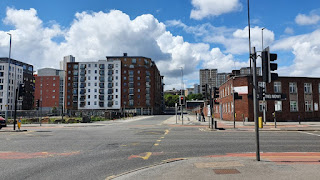 |
| Or here? |
Richard Hanson, one of the founders of Superior Software had previously written games for Micro Power. In an odd coincidence, Micro Power were also based in the LS7 postcode area, on a road called Regent Street, in a building called Regent House; but
a different one.
Tynesoft
Unit 3 Addison Industrial Estate, Blaydon, Tyne & Wear, NE21
Tynesoft is my story of failure, hope, failure, more hope, more failure, a bit more hope, and a disappointing final near miss. The company was always on my would-be-nice-to-do list but I just couldn't justify a trip to Newcastle upon Tyne. The city is just too far out of my normal orbit to be practical. So I set the company aside, which was a shame because it's definitely one I wanted to cover. (Failure).
I had the inevitable dodgy C90 full of pirated games as a kid and I recall diligently ploughing through the tape, determined to play each game at least once. Auf Wiedersehen Pet, the first Tynesoft release, was one on that tape and it was terrible. The game had a lovely picture of Jimmy Nail on the loading screen, but check out the cover photo; carefully chosen to avoid having to pay image royalties to any of the actors from the series.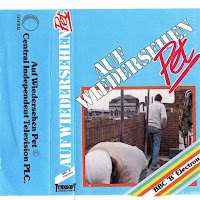
Tynesoft is a classic example of a publisher that could only exist in the very specific conditions of the UK software industry at the time. They were able to make a living releasing games for machines overlooked by bigger publishers; the C16/+4, the MSX, the BBC Micro, the Acorn Electron, and the Atari 400/800 computers. Tynesoft got so good at this that they were able to start buying the rights to games from other companies and converted them to these minority home computers; Alligata's Who Dares Wins II for the C16; and for Acorn's BBC Micro, Software Projects' Jet Set Willy and Jet Set Willy II and a couple of First Star games from America, Spy vs Spy, and Boulder Dash.

Tynesoft also made the transition to the Amiga and Atari ST where they released a terrible Superman game (this was different to Beyond's terrible Superman game) and in 1990 a licenced version of the 1984 film Beverley Hills Cop. This last game was completed following a £5000 offer from the official receiver, as programmer Kevin Blake told RETRO GAMER (issue 75 page 36), "Tynesoft went bust because, as a company, it was tied to a print works that went belly-up." The official receiver locked the building on Friday and the office was burned out in an arson attack, although as graphics artist Phil Scott added, "luckily it was so damp in there that the fire didn't take full hold, and so it was mostly smoke damage."
Suddenly, in mid-March 2024, I had a reason to visit Newcastle. (Hope). A friend was running the Tyne Bridges to Boundaries ultramarathon; an ultra marathon being a 32 mile road race for people who feel a regular marathon is not far enough. This is plainly a very silly thing to do. I offered to go along and provide moral support on the day of the race, and then spend the following day driving round photographing buildings on industrial estates in the Tyne-Tees region; which is plainly not a very silly thing to do. So I looked up the Addison Industrial Estate and immediately stalled. The address I had gave me the road but not the building number. All I had to go on were some photos posted online, here, which yielded no results on Streetview. We are, of course, talking about 34-odd years ago, plenty of time for Tynesoft's building to be rebuilt beyond recognition or just demolished. (Failure). Then I found Acorn Electron World, an archive site which included scans of inlays and adverts and gave me a more complete address; Unit 3. (More hope). Except, the Addision Industrial Estate doesn't number its units, at least not any more. (More failure).
 |
| March 2024 |
On the Saturday of the race I ended up passing the entrance to the Addison Industrial Estate several times. It's close to a road called King Oswald Drive which proved to be a good place to park while waiting to offer moral support for my friend's return trip down the banks of the Tyne. My friend and her partner are both well aware of my [perfectly rational] hobby and I was able to stop and grab a couple of photos of the entrance to the estate. During the course of which I was able to also take this picture.
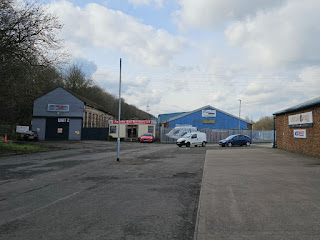 |
| March 2024 |
Note how the building on the left has Unit 2 painted on the door in big friendly letters. (A bit more hope). However, that hope led nowhere. Logically one of the two buildings next to it should be Unit 3 but neither of them have that address or look like any of the old photos showing the Tynesoft building.
(Disappointing final near miss).
Follow me on Bluesky @shammountebank.bsky.social. If you have any idea of where these companies really were then leave a comment or send an email to whereweretheynow@gmail.com This is also the bit where I grovel for support. If you've enjoyed this blog or at least read a couple of entries without thinking "what a sad man," too many times, then drop a link on any relevant forums or Facebook groups you inhabit.
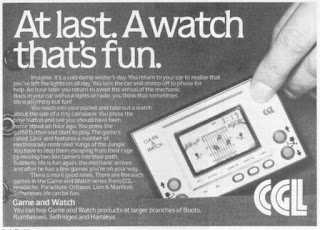
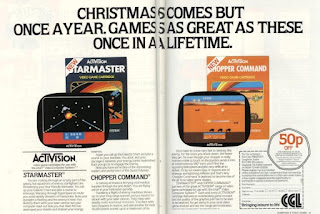










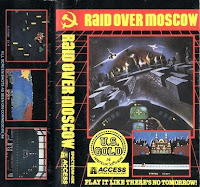
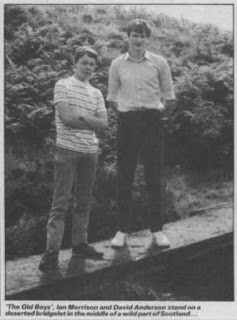


_cover.jpg)



.jpg)




No comments:
Post a Comment